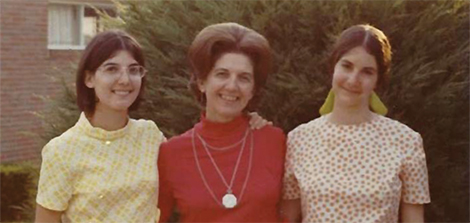Sitting across from Sylvia Nathanson ’71, social work, it’s hard not to see the spark that propelled her in her late forties to become one of UMBC’s first returning students – and led her to a prominent role in educating thousands of social workers as the longtime dean of admissions at the University of Maryland School of Social Work.
She is 98 years old now, but Nathanson’s memories of the university’s formative years remain vivid. “It was a time of great protests,” she says. “There were many speeches all the time. I remember my first biology class, and the head of the protestors was my lab partner.”
Nathanson began taking classes at the age of 46 at Baltimore Junior College (now Baltimore City Community College). In 1968, she was encouraged to transfer to UMBC. She found the university “a wonderful place to be. People were warm and accepting. Helpful. The older student was welcomed.”
Juggling her roles as a mother to two daughters and as a student took discipline and focus, UMBC was accommodating. “I never took a class before nine o’clock or after two o’clock,” she says.
Nathanson did participate in a formative experience for many UMBC students: study abroad. In the 1969 January session (dubbed the “minimester” in that era), Nathanson accompanied Walter Sherwin – now emeritus professor of ancient studies – and a group of her fellow students on a trip to London, Paris, and Rome.
Nathanson recalls hearing about the three-week study course a few months before the trip. “I looked over at the person sitting opposite me, and I said, ‘Golly, that’s a wonderful idea! Why don’t you do it?’ And she looked me square in the eye and said, ‘Why don’t you?’ And I did.”
The trip pushed the first-time traveler in unexpected ways. “We had a flat front bus, and we were riding down a narrow road [in Italy], and everybody took a turn riding in front to see the water below,” Nathanson remembers. “Now I was someone who didn’t like the water and didn’t like heights. But one of the students piped up and said: ‘Everyone’s had a turn. But Sylvia hasn’t had a turn.’ And they put me right up front. And I grew. It sounds ridiculous. But I grew tremendously during that experience.”
Sherwin remembers the minimester trips and their beneficial effects on students. “It expanded the horizons for a lot of people,” he says.
Nathanson soon put the growth she experienced as a student and world traveler to even more beneficial uses. She says she found her calling when Ruth Young, the legendary dean of the University of Maryland School of Social Work, came to UMBC to recruit students. “Dean Young came to campus to explain how she envisioned a bachelor’s degree in social work,” she recalls. “She was really explaining social work that day. After that, there was never a question.”
Young’s advocacy helped created a powerful new program at UMBC. “Once it got going,” says Nathanson, “the [social work] program became tremendously popular. Because there was such a need for it.”
After graduating cum laude from UMBC, Nathanson worked as a social worker at Baltimore City Hospitals (now Johns Hopkins Bayview Medical Center). “UMBC had given me a sense of community and organization,” she says. “And being older, I was able to render a social work service and pulled the community in.”
After five years, however, Nathanson went back to school again, this time to get her master’s degree in social work at the University of Maryland School of Social Work. “The master’s people had something different,” she says. “They had something I wanted. So I took a leave of absence and went to the master’s program.”
Nathanson was a fixture at the School of Social Work after obtaining her advanced degree, eventually becoming the dean of admissions. She encouraged and enrolled many graduates of UMBC in the school and helped them on in their social work careers.
“I followed the UMBC alumnae,” Nathanson recalls. “I have a particular skill. I never forget a name, and that comes in handy.”
—Richard Byrne ’86
Tags: Spring 2016, Sylvia Nathanson

